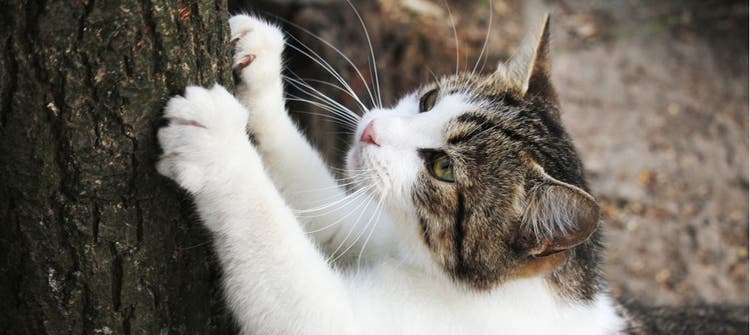
Is Declawing Cats Ethical?
Onychectomy, or declawing, has become an increasingly contentious issue over the last two decades. Prior to 2003, it was legal across the country and many cat lovers probably didn’t think twice about it. It was estimated around that time that about 25% of pet cats had undergone the procedure. When West Hollywood introduced the country’s first community-wide ban, however, declawing instantly became more controversial.
In the years since, animal advocacy organizations have continued to discourage declawing. Both the American Society for the Prevention of Cruelty to Animals (ASPCA) and the U.S. Humane Society (USHS) consider banning declawing an important policy position. The Paw Project, a sponsor of California’s initial ban, considers it their entire mission. They’ve all played an important role in passing legislation and spreading awareness about what onychectomy really entails.
Why Do Cats Scratch?
In a sense, arguments about declawing are actually about a different subject altogether — scratching. Anyone who’s ever owned a cat can attest to the fact that they really, really like to scratch. The USHS notes that cats break out their claws for a number of purposes. They don’t mark up furniture out of spite, but may seek out textured surfaces to mark their territory, shed their claws’ outer layers, or even just to relieve stress. The behavior is instinctual and all but unavoidable. Once a cat begins scratching (usually around 8 weeks of age) cat owners can begin training them to do so appropriately and avoid both property damage and surgery.
How Does Declawing Work?
Onychectomy is not at all the same as clipping a cat’s nails. It involves the total removal of a cat’s toe bones as well as their claws. Typically, veterinarians will only perform the procedure on a cat’s front paws. They can do so with surgical clippers, a scalpel, or a laser. Opponents of the procedure suggest that this is analogous to amputating a person’s fingers at the knuckle.
Arguments Against Declawing
The declawing procedure has grown controversial for a reason. It’s compellingly associated with a number of physical and behavioral side effects. During their recovery period, cats may suffer from pain, infection, limping, and more severe issues like nerve damage. Throughout the rest of their lives, they will walk differently. This can leave some cats dealing with constant pain and discomfort. Research also suggests that declawed cats may begin to exhibit other destructive behaviors like biting or neglecting to use a litter box.
Defending Declawing
You won’t find many emphatic defenses for declawing as an elective procedure. Even veterinarians and veterinary groups who defend it tend to do so in hopes of keeping it as a potential emergency option. Dr. Alan M. Beck took to the pages of the New York Times to make this exact argument in 2015. “There are strategies,” Beck writes, “to lessen behavior problems but many cats are just not able to resist scratching so owners abandon them or give them to shelters.” Declawing, Beck suggests, is a “reasonable alternative” compared to relinquishing or euthanizing pets.
The American Veterinary Medical Association’s (AVMA) official stance is similar. While discouraging declawing as an elective or cosmetic procedure, they acknowledge that some situations may warrant it. They advise veterinarians to help cat owners educate themselves on the potential risks and drawbacks of declawing, as well as the available alternatives.
The California Veterinary Medical Association (CVMA) fought its state’s initial bans for years. It was even briefly successful in overturning West Hollywood’s anti-declawing law. The group did not, however, address the procedure’s animal welfare implications. Rather, CVMA opposed the law on the grounds that it infringed upon the rights of individual veterinarians. Since 2010, it has been illegal for local governments to ban the procedure.
Declawing Bans
A number of communities and one entire state have followed West Hollywood’s lead:
- California: Several large cities including Beverly Hills, Los Angeles, and San Francisco introduced declawing bans before 2010 and, as such, these laws are still in place. State-wide, property-owners in pet-friendly buildings cannot demand that tenants declaw their cats.
- Colorado: The city of Denver banned declawing as an elective or cosmetic procedure in 2017.
- New York: Governor Andrew Cuomo banned the procedure statewide on July 22nd, 2019.
- Rhode Island: As of 2013, landlords in pet-friendly buildings cannot demand that a tenant declaw their cat.
Though anti-declawing laws are still relatively rare in the states, public opinion appears to have changed considerably over the last decade. In 2010, the Associated Press found that 60% of pet owners and 55% of cat owners were okay with the surgery. Following New York’s recent ban, Today’s Veterinary News polled thousands of pet owners and veterinary professionals. They found overwhelming support for banning declawing among both groups.
Alternatives to Declawing
Cat owners can best address excessive, destructive scratching by discouraging the behavior as early as possible. Your cat will inevitably sink their claws into furniture and household items — they can’t help it. While punishment and negative reinforcement won’t do you any good, the following steps can help you save your home without resorting to onychectomy:
- Asking your veterinarian about replaceable nail caps and other scratching deterrents.
- Cutting your cat’s nails regularly to minimize the impact of scratches.
- Redirecting scratching with new, appropriate surfaces like scratching posts. You can use toys and catnip to help.
- Offering positive reinforcement for appropriate scratching.
Like other controversial procedures, declawing is generally discouraged except when recommended by a veterinary professional. From the AVMA to the ASPCA, nearly all animal-friendly organizations recommend exhausting all of the above alternatives before discussing it with your vet.